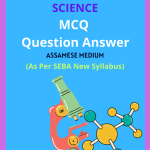Class 7 Science MCQ Chapter 17 Forests: Our Life Line Solutions in English Medium, Class 7 Science Multiple Choice Question Answer in English to each chapter is provided in the list so that you can easily browse throughout different chapters Class 7 Science MCQ Chapter 17 Forests: Our Life Line Notes and select need one.
Class 7 Science MCQ Chapter 17 Forests: Our Life Line
Also, you can read the SCERT book online in these sections Class 7 Science Objective Type Solutions by Expert Teachers as per SCERT (CBSE) Book guidelines. These solutions are part of SCERT All Subject Solutions. Here we have given Assam Class 7 Science MCQs Solutions in English for All Subject, You can practice these here.
Forests: Our Life Line
Chapter – 17
| MCQ |
1. Which of the following is not a scavenger?
(a) Crow.
(b) Jackal.
(c) Lion.
(d) Vulture.
Ans: (c) Lion.
2. What is the uppermost layer of vegetation in a forest?
(a) Herbs.
(b) Shrubs.
(c) Trees.
(d) Micro-organisms.
Ans: (c) Trees.
3. Which of the following will help in the conservation of forests?
(a) Recycling of jute bags.
(b) Recycling of cotton bags.
(c) Recycling of paper bags.
(d) Recycling of plastic bags.
Ans: (c) Recycling of paper bags.
4. Which of the following is a role of forests in the environment?
(a) Promoting industrial activities.
(b) Protecting soil from erosion.
(c) Reducing biodiversity.
(d) Increasing pollution.
Ans: (b) Protecting soil from erosion.
5. Which of the following is not a correct statement?
(a) Forest trees are cut down to obtain timber.
(b) Forest trees are cut down to obtain paper.
(c) Forest trees are cut down to obtain natural rubber.
(d) Forest trees are cut down to obtain firewood.
Ans: (c) Forest trees are cut down to obtain natural rubber.
6. What forms the lowest layer of vegetation in a forest?
(a) Trees.
(b) Shrubs.
(c) Herbs.
(d) Moss.
Ans: (c) Herbs.
7. Which of the following is not a function of the crowns of forest trees during the daytime?
(a) Absorb sunlight energy.
(b) Absorb oxygen from air.
(c) Carry out photosynthesis.
(d) Form a green cover.
Ans: (b) Absorb oxygen from air.
8. How do forests influence the climate?
(a) By increasing soil erosion.
(b) By affecting air quality and water cycle.
(c) By reducing plant growth.
(d) By limiting biodiversity.
Ans: (b) By affecting air quality and water cycle.
9. Deforestation results in:
(a) Increased rainfall.
(b) Increase in earth’s temperature.
(c) Increase in water level.
(d) Conservation of soil.
Ans: (b) Increase in earth’s temperature.
10. What is the relationship between forests and soil?
(a) Forests degrade soil quality.
(b) Soil helps forests to grow and regenerate.
(c) Forests and soil do not interact.
(d) Forests remove soil nutrients.
Ans: (b) Soil helps forests to grow and regenerate.
11. What are the consequences of deforestation?
(a) Lesser rainfall, danger to wildlife.
(b) Imbalance between the oxygen-carbon dioxide cycle in the atmosphere.
(c) Increased air pollution and soil erosion.
(d) All of the above.
Ans: (d) All of the above.
12. From the following, which is best for the conservation of forests?
(a) Plantation of indigenous or exotic species to develop forests in all the available land.
(b) The forest reserves must be protected from fuel-starved villages, fodder-starved cattle, and commercial exploitation.
(c) Indiscriminate felling of trees for the purpose of timber must be reduced.
(d) All of the above.
Ans: (d) All of the above.
13. The micro-organisms which convert the dead plants and animals to humus are known as:
(a) Humus.
(b) Decomposers.
(c) Dynamic living entity.
(d) None of the above.
Ans: (b) Decomposers.
14. What name is given to the branchy part of a tree above the stem?
(a) Canopy.
(b) Humus.
(c) Crown.
(d) Climate conditions.
Ans: (c) Crown.
15. Write a food chain which operates in a forest ecosystem:
(a) Grass → Tiger → Deer.
(b) Tiger → Deer → Grass.
(c) Grass → Deer → Tiger.
(d) All of the above.
Ans: (c) Grass → Deer → Tiger.

Hi! my Name is Parimal Roy. I have completed my Bachelor’s degree in Philosophy (B.A.) from Silapathar General College. Currently, I am working as an HR Manager at Dev Library. It is a website that provides study materials for students from Class 3 to 12, including SCERT and NCERT notes. It also offers resources for BA, B.Com, B.Sc, and Computer Science, along with postgraduate notes. Besides study materials, the website has novels, eBooks, health and finance articles, biographies, quotes, and more.



